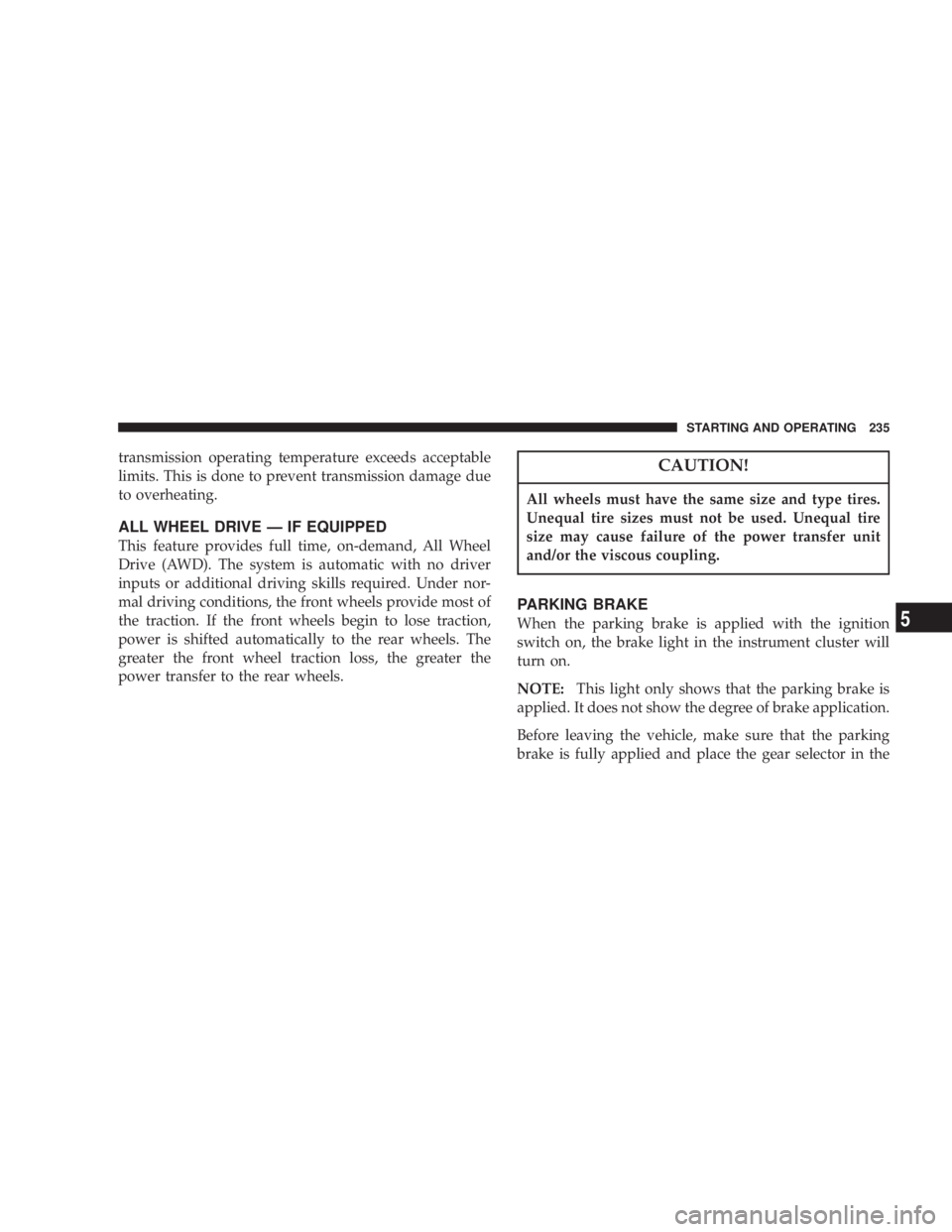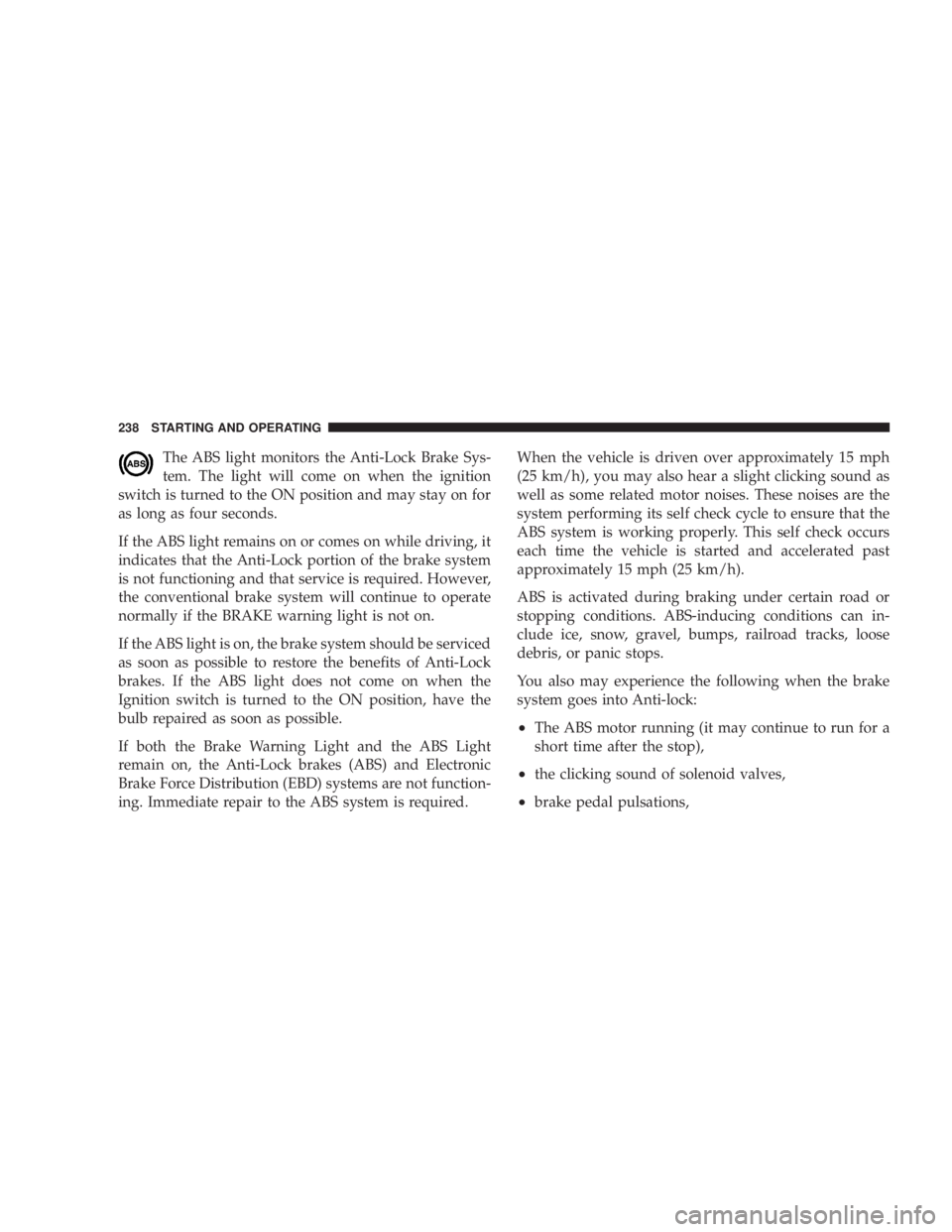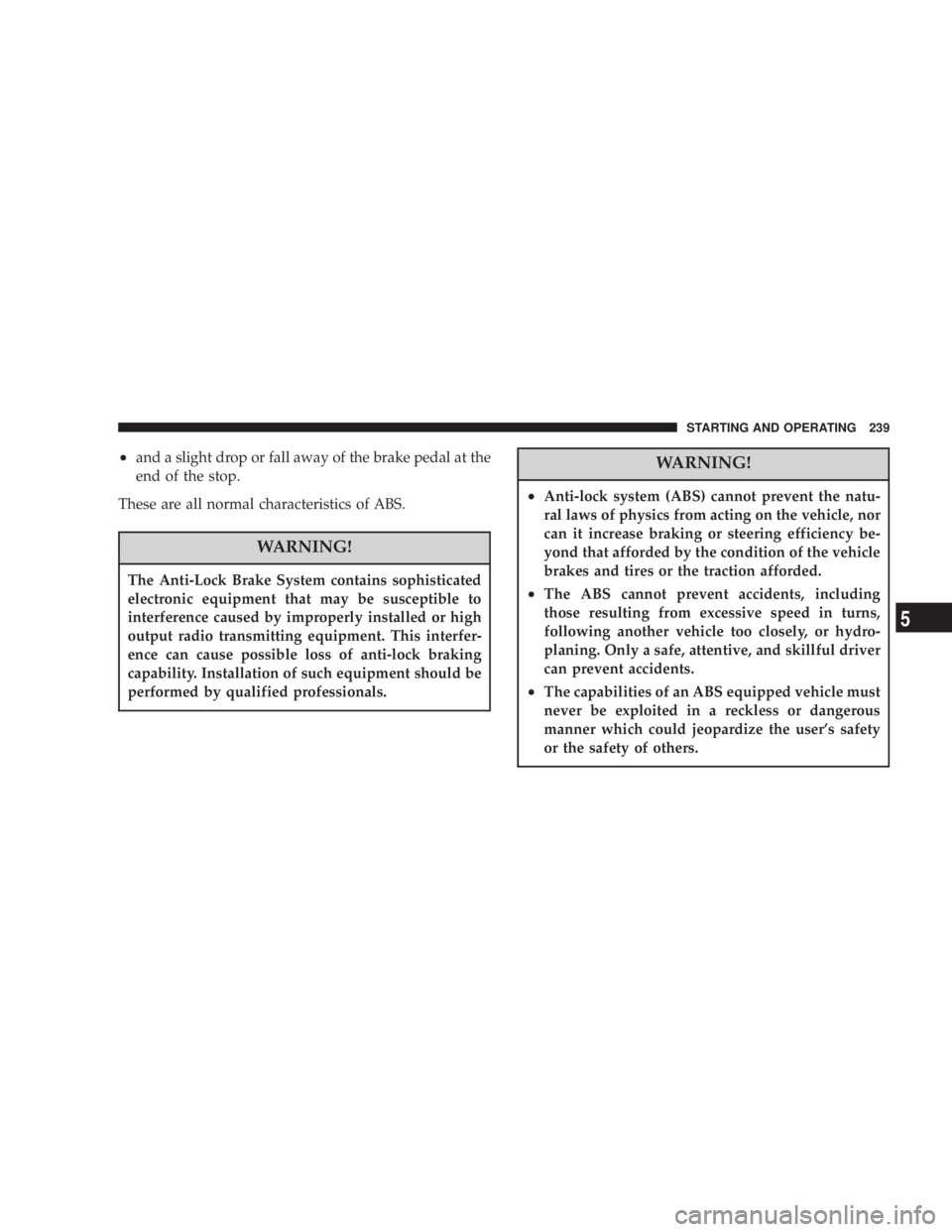2004 DODGE GRAND CARAVAN brake light
[x] Cancel search: brake lightPage 235 of 397

transmission operating temperature exceeds acceptable
limits. This is done to prevent transmission damage due
to overheating.
ALL WHEEL DRIVE Ð IF EQUIPPED
This feature provides full time, on-demand, All Wheel
Drive (AWD). The system is automatic with no driver
inputs or additional driving skills required. Under nor-
mal driving conditions, the front wheels provide most of
the traction. If the front wheels begin to lose traction,
power is shifted automatically to the rear wheels. The
greater the front wheel traction loss, the greater the
power transfer to the rear wheels. CAUTION!All wheels must have the same size and type tires.
Unequal tire sizes must not be used. Unequal tire
size may cause failure of the power transfer unit
and/or the viscous coupling.
PARKING BRAKE
When the parking brake is applied with the ignition
switch on, the brake light in the instrument cluster will
turn on.
NOTE: This light only shows that the parking brake is
applied. It does not show the degree of brake application.
Before leaving the vehicle, make sure that the parking
brake is fully applied and place the gear selector in the STARTING AND OPERATING 235
5
Page 238 of 397

The ABS light monitors the Anti-Lock Brake Sys-
tem. The light will come on when the ignition
switch is turned to the ON position and may stay on for
as long as four seconds.
If the ABS light remains on or comes on while driving, it
indicates that the Anti-Lock portion of the brake system
is not functioning and that service is required. However,
the conventional brake system will continue to operate
normally if the BRAKE warning light is not on.
If the ABS light is on, the brake system should be serviced
as soon as possible to restore the benefits of Anti-Lock
brakes. If the ABS light does not come on when the
Ignition switch is turned to the ON position, have the
bulb repaired as soon as possible.
If both the Brake Warning Light and the ABS Light
remain on, the Anti-Lock brakes (ABS) and Electronic
Brake Force Distribution (EBD) systems are not function-
ing. Immediate repair to the ABS system is required. When the vehicle is driven over approximately 15 mph
(25 km/h), you may also hear a slight clicking sound as
well as some related motor noises. These noises are the
system performing its self check cycle to ensure that the
ABS system is working properly. This self check occurs
each time the vehicle is started and accelerated past
approximately 15 mph (25 km/h).
ABS is activated during braking under certain road or
stopping conditions. ABS-inducing conditions can in-
clude ice, snow, gravel, bumps, railroad tracks, loose
debris, or panic stops.
You also may experience the following when the brake
system goes into Anti-lock:
² The ABS motor running (it may continue to run for a
short time after the stop),
² the clicking sound of solenoid valves,
² brake pedal pulsations,238 STARTING AND OPERATING
Page 239 of 397

² and a slight drop or fall away of the brake pedal at the
end of the stop.
These are all normal characteristics of ABS.
WARNING!The Anti-Lock Brake System contains sophisticated
electronic equipment that may be susceptible to
interference caused by improperly installed or high
output radio transmitting equipment. This interfer-
ence can cause possible loss of anti-lock braking
capability. Installation of such equipment should be
performed by qualified professionals. WARNING!² Anti-lock system (ABS) cannot prevent the natu-
ral laws of physics from acting on the vehicle, nor
can it increase braking or steering efficiency be-
yond that afforded by the condition of the vehicle
brakes and tires or the traction afforded.
² The ABS cannot prevent accidents, including
those resulting from excessive speed in turns,
following another vehicle too closely, or hydro-
planing. Only a safe, attentive, and skillful driver
can prevent accidents.
² The capabilities of an ABS equipped vehicle must
never be exploited in a reckless or dangerous
manner which could jeopardize the user's safety
or the safety of others. STARTING AND OPERATING 239
5
Page 276 of 397

² The trailer tongue load must be considered as part of
the combined weight of occupants and cargo, and
should never exceed the weight referenced on the Tire
and Loading Information placard. Refer to the Tire±
Safety Information Section in this manual.
² The ªDº range can be selected when towing. However,
if frequent shifting occurs while in this range, the ª3º
range must be selected.
NOTE: Using the ª3º range while operating the vehicle
under heavy operating conditions will improve perfor-
mance and extend transaxle life by reducing excessive
shifting and heat build up.
WARNING!Connecting trailer brakes to your vehicle's hydraulic
brake lines can overload your brake system and
cause it to fail. You might not have brakes when you
need them and could have an accident. ² Do not attempt to tow a trailer while using a compact
spare tire.
² Whenever you pull a trailer, regardless of the trailer
size, stop lights and turn signals on the trailer are
recommended for motoring safety.
² The automatic transaxle fluid and filter should be
changed if you REGULARLY tow a trailer for more
than 45 minutes of continuous operation. See Schedule
ªBº in section 8 of this manual for transaxle fluid
change intervals.
NOTE: Check the automatic transaxle fluid level before
towing. Fluid discoloration, or a burnt odor, shows the
need for a transmission fluid and filter change.276 STARTING AND OPERATING
Page 296 of 397

N Front Suspension Ball Joints ..............314
N Steering Shaft Seal ....................314
N Steering Linkage ......................315
N Drive Shaft Universal Joints ..............315
N Body Lubrication .....................315
N Windshield Wiper Blades ................316
N Windshield And Rear Window Washers .....316
N Exhaust System ......................317
N Cooling System .......................318
N Hoses And Vacuum/Vapor Harnesses .......322
N Brakes .............................323
N Master Cylinder Ð ABS Brakes Brake Fluid
Level Check .........................324 N Fuel System Hoses ....................326
N Automatic Transmission ................326
N All Wheel Drive (AWD) .................329
N Front And Rear Wheel Bearings ...........330
N Appearance Care And Protection From
Corrosion ...........................330
N Cleaning The Instrument Panel And
Underseat Cup Holders .................334
m Integrated Power Module (IPM) ............336
m Vehicle Storage ........................337
m Replacement Light Bulbs .................338
m Bulb Replacement ......................339
N Headlights ..........................339296 MAINTAINING YOUR VEHICLE
Page 324 of 397

Insure nylon tubing in these areas has not melted or
collapsed.
Inspect all hose connections such as clamps and cou-
plings to make sure they are secure and no leaks are
present.
NOTE: Often, fluid such as oil, power steering fluid,
and brake fluid are used during assembly plant opera-
tions to facilitate the assembly of hoses to couplings.
Therefore, oil wetness at the hose-coupling area is not
necessarily an indication of leakage. Actual dripping of
hot fluid when systems are under pressure (during
vehicle operation), should be noted before hose is re-
placed based on leakage.
NOTE: Inspection of brake hoses should be performed
whenever the brake system is serviced and every engine
oil change. Inspect hydraulic brake hoses for surface
cracking, scuffing, or worn spots. If there is any evidence
of cracking, scuffing, or worn spots, the hose should be replaced immediately! Eventual deterioration of the hose
can take place resulting in a possibility of a burst failure.
WARNING!Worn brake hoses can burst and cause brake failure.
You could have an accident. If you see any signs of
cracking, scuffing, or worn spots, have the brake
hoses replaced immediately.
Master Cylinder Ð ABS Brakes Brake Fluid Level
Check
The fluid level in the master cylinder should be checked
when performing underhood services, or immediately if
the brake system warning light indicates system failure.
Clean the top of the master cylinder area before removing
the cap. Add fluid to bring the level up to the top of the
ªFULLº mark on the side of the master cylinder reservoir.324 MAINTAINING YOUR VEHICLE
Page 349 of 397

² Taxi, police, or delivery service (commercial ser-
vice). L
² Off-road or desert operation.
NOTE: Most vehicles are operated under the conditions
listed for Schedule 9 B 9 .
Second is Schedule ªAº . It is for vehicles that are not
operated under any of the conditions listed under Sched-
ule 9 B 9 .
Use the schedule that best describes your driving condi-
tions. Where time and mileage are listed, follow the
interval that occurs first.
CAUTION!Failure to perform the required maintenance items
may result in damage to the vehicle. At Each Stop for Fuel
² Check the engine oil level about 5 minutes after a fully
warmed engine is shut off. Checking the oil level while
the vehicle is on level ground will improve the accu-
racy of the oil level reading. Add oil only when the
level is at or below the ADD or MIN mark.
² Check the windshield washer solvent and add if
required.
Once a Month
² Check tire pressure and look for unusual wear or
damage.
² Inspect the battery and clean and tighten the terminals
as required.
² Check the fluid levels of coolant reservoir, brake
master cylinder and transmission; add as needed.
² Check all lights and all other electrical items for correct
operation. MAINTENANCE SCHEDULES 349
8 M
A
I
N
T
E
N
A
N
C
E
S
C
H
E
D
U
L
E
S
Page 382 of 397

Adding Fuel ........................... 270
Adding Washer Fluid .................. 221,316
Additives, Fuel ......................... 268
Adjustable Pedals ....................... 106
Air Conditioner Maintenance ............... 312
Air Conditioning ..................... 199,203
Air Conditioning Controls ................. 199
Air Conditioning Filter ................. 219,313
Air Conditioning, Operating Tips ............ 218
Air Conditioning, Rear Zone ............. 206,214
Air Conditioning Refrigerant ............... 312
Air Conditioning System .......... 199,203,208,312
Air Conditioning System, Zone Control ........ 200
Air Pressure, Tires ....................... 252
Airbag ................................ 48
Airbag Deployment ....................... 55
Airbag Light ..................... 52,57,72,152
Airbag Maintenance ....................... 57
Airbag, Side ............................ 54 Alarm Light ........................... 154
Alarm System ........................... 26
Alignment and Balance ................... 258
All Wheel Drive ................... 235,259,329
Alterations/Modifications, Vehicle ............. 7
Antifreeze Disposal ...................... 321
Antifreeze (Engine Coolant) .............. 319,320
Anti-Lock Brake System ................... 237
Anti-Lock Warning Light .................. 153
Anti-Theft Security Alarm .................. 26
Appearance Care ........................ 330
Ashtray ............................... 130
Auto Down Power Windows ................ 37
Automatic Dimming Mirror ................. 77
Automatic Door Locks ..................... 19
Automatic Headlights .................... 100
Automatic Temperature Control ............. 208
Automatic Transaxle ................... 231,326
Adding Fluid ......................... 345382 INDEX